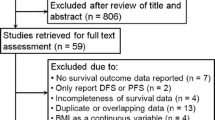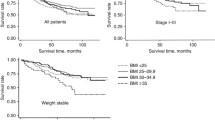Abstract
Body mass index (BMI), as an approximation of general adiposity, is an established risk factor for incidence of several adult cancer types, including colorectal cancer (CRC). There is a common perception that these relationships extrapolate directly as adverse prognostic factors after diagnosis, but evidence for this is lacking. The paper from Sclesinger et al. in this issue of the journal adds a new dimension to this debate focusing on relationships of post-diagnosis BMI (as a marker of the steady-state weight among survivors) and survival, and provides evidence on a decreased mortality risk among overweight (post-diagnosis BMI 25.0–29.9 kg/m2) compared with normal weight (post-diagnosis BMI 18.5–24.9 kg/m2) CRC survivors—an example of an ‘obesity paradox.’ The observation of the ‘obesity paradox’ is well documented in the methodology literature, but perhaps, less familiar to the cancer readership. Three broad classes of explanation are posited: (1) the associations are true and plausible; (2) the associations are false and reflect methodological issues; or (3) the observations represent a specific form of selection bias, known as collider bias. The present author argues that the obesity paradox reflects the latter—a product of a statistical bias—and emphasizes that, while these findings are hypothesis generating, they will not alter clinical practice or recommendations.

Similar content being viewed by others
References
World Cancer Research Fund (WCRF) (2007) Food, nutrition, physical activity, and the prevention of cancer: a global perspective, 2nd edn. American Institute for Cancer Research, Washington
Renehan A, Tyson M, Egger M, Heller RF, Zwahlen M (2008) Body mass index and incidence of cancer: a systematic review and meta-analysis of prospective observational studies. Lancet 371:569–578
Doyle C, Kushi LH, Byers T et al (2006) Nutrition and physical activity during and after cancer treatment: an American Cancer Society guide for informed choices. CA Cancer J Clin 56:323–353
Parkin E, O’Reilly DA, Sherlock DJ, Manoharan P, Renehan AG (2014) Excess adiposity and survival in patients with colorectal cancer: a systematic review. Obes Rev 15:434–451
Schlesinger S, Siegert S, Koch M et al. (2014) Postdiagnosis body mass index and risk of mortality in colorectal cancer survivors: a prospective study and meta-analysis. Cancer Causes Control. doi:10.1007/s10552-014-0435-x
Carnethon MR, De Chavez PJ, Biggs ML et al (2012) Association of weight status with mortality in adults with incident diabetes. JAMA 308:581–590
Logue J, Walker JJ, Leese G et al (2013) Association between BMI measured within a year after diagnosis of type 2 diabetes and mortality. Diabetes Care 36:887–893
Tobias DK, Pan A, Jackson CL et al (2014) Body-mass index and mortality among adults with incident type 2 diabetes. N Engl J Med 370:233–244
Lavie CJ, Milani RV, Ventura HO (2009) Obesity and cardiovascular disease: risk factor, paradox, and impact of weight loss. J Am Coll Cardiol 53:1925–1932
Romero-Corral A, Montori VM, Somers VK et al (2006) Association of bodyweight with total mortality and with cardiovascular events in coronary artery disease: a systematic review of cohort studies. Lancet 368:666–678
Oreopoulos A, Padwal R, Kalantar-Zadeh K, Fonarow GC, Norris CM, McAlister FA (2008) Body mass index and mortality in heart failure: a meta-analysis. Am Heart J 156:13–22
Carman WJ, Barrett-Connor E, Sowers M, Khaw KT (1994) Higher risk of cardiovascular mortality among lean hypertensive individuals in Tecumseh, Michigan. Circulation 89:703–711
Landbo C, Prescott E, Lange P, Vestbo J, Almdal TP (1999) Prognostic value of nutritional status in chronic obstructive pulmonary disease. Am J Respir Crit Care Med 160:1856–1861
Yoon HH, Lewis MA, Shi Q et al (2011) Prognostic impact of body mass index stratified by smoking status in patients with esophageal adenocarcinoma. J Clin Oncol 29:4561–4567
Hakimi AA, Furberg H, Zabor EC et al (2013) An epidemiologic and genomic investigation into the obesity paradox in renal cell carcinoma. J Natl Cancer Inst 105:1862–1870
Parker AS, Lohse CM, Cheville JC, Thiel DD, Leibovich BC, Blute ML (2006) Greater body mass index is associated with better pathologic features and improved outcome among patients treated surgically for clear cell renal cell carcinoma. Urology. 68:741–746
Crosbie EJ, Zwahlen M, Kitchener HC, Egger M, Renehan AG (2010) Body mass index, hormone replacement therapy, and endometrial cancer risk: a meta-analysis. Cancer Epidemiol Biomark Prev 19:3119–3130
Crosbie EJ, Roberts C, Qian W, Swart AM, Kitchener HC, Renehan AG (2012) Body mass index does not influence post-treatment survival in early stage endometrial cancer: results from the MRC ASTEC trial. Eur J Cancer 48:853–864
Yang XR, Chang-Claude J, Goode EL et al (2011) Associations of breast cancer risk factors with tumor subtypes: a pooled analysis from the breast cancer association consortium studies. J Natl Cancer Inst 103:250–263
Speakman JR (2014) If body fatness is under physiological regulation, then how come we have an obesity epidemic? Physiol (Bethesda) 29:88–98
Rothman KJ (2008) BMI-related errors in the measurement of obesity. Int J Obes (Lond) 32(Suppl 3):S56–S59
Vina J, Borras C, Gomez-Cabrera MC (2013) Overweight, obesity, and all-cause mortality. JAMA 309:1679
Durazo-Arvizu RA, Cooper RS (2008) Issues related to modeling the body mass index-mortality association: the shape of the association and the effects of smoking status. Int J Obes (Lond) 32(Suppl 3):S52–S55
Strandberg TE, Stenholm S, Strandberg AY, Salomaa VV, Pitkala KH, Tilvis RS (2013) The “obesity paradox,” frailty, disability, and mortality in older men: a prospective, longitudinal cohort study. Am J Epidemiol 178:1452–1460
Flegal KM, Graubard BI, Williamson DF, Cooper RS (2011) Reverse causation and illness-related weight loss in observational studies of body weight and mortality. Am J Epidemiol 173:1–9
Lawlor DA, Hart CL, Hole DJ, Davey SG (2006) Reverse causality and confounding and the associations of overweight and obesity with mortality. Obes (Silver Spring) 14:2294–2304
Renehan AG, Crosbie EJ, Campbell PT (2014) Re: prediagnosis body mass index, physical activity, and mortality in endometrial cancer patients. J Natl Cancer Inst 106:djt375
Hernan MA, Hernandez-Diaz S, Robins JM (2004) A structural approach to selection bias. Epidemiology 15:615–625
Cole SR, Platt RW, Schisterman EF et al (2010) Illustrating bias due to conditioning on a collider. Int J Epidemiol 39:417–420
Hernandez-Diaz S, Schisterman EF, Hernan MA (2006) The birth weight “paradox” uncovered? Am J Epidemiol 164:1115–1120
Acknowledgments
I would like to acknowledge the academic discussions with many colleagues around the world on obesity, cancer, and the interpretation of casual pathways.
Conflict of interest
None.
Author information
Authors and Affiliations
Corresponding author
Additional information
This article has been retracted at the request of the Editor-in-Chief, as it contains large portions of text that have been duplicated from the article: "The obesity paradox: understanding the effect of obesity on mortality among individuals with cardiovascular disease"; Banack HR, Kaufman JS; Preventive Medicine 2014 May;62:96-102; DOI: 10.1016/j.ypmed.2014.02.003.
About this article
Cite this article
Renehan, A.G. RETRACTED ARTICLE: The ‘obesity paradox’ and survival after colorectal cancer: true or false?. Cancer Causes Control 25, 1419–1422 (2014). https://doi.org/10.1007/s10552-014-0436-9
Received:
Accepted:
Published:
Issue Date:
DOI: https://doi.org/10.1007/s10552-014-0436-9




